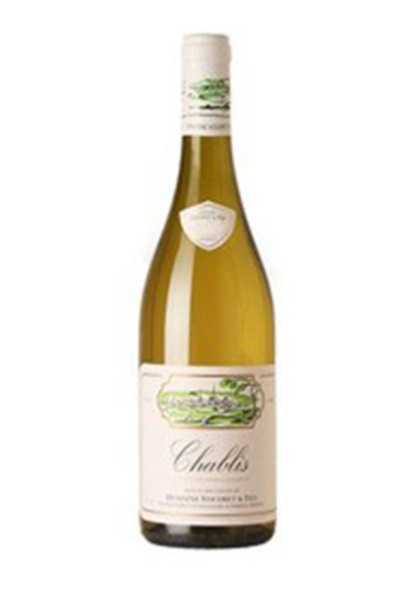Close
Vocoret & Fills Chablis
France

- Brand: Vocoret
- Categories: Chardonnay, White Wine
- ABV:12%
- Food Pairing: Fish - Meaty & Oily, Shellfish, Cheese - Fresh & Soft
- Suggested Glassware: Chardonnay Glass
- Suggested Serving Temperature: 50-55° F
- Sweet-Dry Scale: Dry Wine
- Body: Full
Chablis is an historic wine-producing town in northern-central France. It produces light, dry white wines famed for their minerality and crisp acidity. AOC Chablis wines are produced exclusively from Chardonnay. Chablis is located in northern Burgundy (Bourgogne), although the town and its vineyards are located a considerable distance (more than 60 miles/100 km) north-west of Burgundy's main wine-producing areas around Nuits-Saint-Georges, Beaune, Chalon-sur-Saone and Macon. They are in fact closer to Sancerre (Loire) and Les Riceys (southern Champagne). Consequently, Chablis has a cooler climate than the rest of Burgundy, which contributes significantly to the style of wine its vineyards produce. The effects of terroir on wine can be seen more clearly in Chablis than almost anywhere else. Chablis Vineyards in Chablis A key division within Chablis lies between terroirs with Kimmeridgian soils and those with Portlandian soils. Kimmeridgian soil is more highly regarded; it contains greater levels of mineral-rich clay, as well as the essential marine fossils which are responsible for its significant lime content. Kimmeridgian soils are the source of the trademark minerality in Premier Cru and Grand Cru wines from Chablis. By contrast, Portlandian soils are not so rich in clay and fossils, which results in slightly fruitier wines with a less mineral profile. Petit Chablis wines are most often grown in Portlandian soils. Chablis wines are made in a style rather different from those produced elsewhere in Burgundy. They are drier and fresher, rather than more weighty and richly flavored. Unlike typical Burgundian white wines, which are barrel fermented, Chablis is usually entirely free of any oak influence. Very few Chablis producers use oak barrels in their winemaking and the exceptions are restricted to the higher-quality wines, whose extra complexity and depth mean that the wines are not overpowered by oak flavors. The vineyards of Chablis are classified into four tiers of quality. Starting from the top, they are: Chablis Grand Cru, Chablis Premier Cru, Chablis and Petit Chablis. Wines which conform to the general Chablis appellation laws may claim the classification held by the vineyard where they were grown. The appellation AOC Chablis is the most prolific and geographically widespread of the four classifications. It was created in 1938 – at the same time as the Chablis Grand Cru appellation – to protect the Chablis name, which was being used around the world to describe wines bearing little resemblance to the real Chablis. Today, all wines carrying the Chablis title are dry whites made exclusively from Chardonnay. They must be produced from vineyards in a specifically designated area surrounding Chablis town and its nearby villages. Chablis Premier Cru is not a distinct appellation like the other three classifications, but rather a quality sub-division of the standard AOC Chablis title. Its geographical coverage is significantly larger than that of Chablis Grand Cru. There are 40 climats (vineyard sites) around Chablis which are deemed worthy of the Premier Cru title, and these are further subdivided into roughly 80 specific vineyards. The wines produced under this title are made according to quality controls that are halfway between those of the Chablis and Grand Cru Chablis appellations. Chablis Grand Cru wines are produced from just 250 acres (100ha) of vineyards planted on gentle south-west-facing slopes at the eastern edge of the town. There are seven named Grand Cru climats. Running from north to south along the Serein river they are: Preuses, Bougros, Vaudesir, Grenouilles, Valmur, Les Clos and Blanchot. Wines claiming the Grand Cru title are made under stringent regulations; the maximum permitted yield is lower than for standard Chablis, and the minimum potential alcohol one degree higher. Chablis Grand Cru wines respond well to bottle ageing for between 10 and 15 years. Petit Chablis is the least prestigious of the Chablis appellations. It was created in 1944 to cover the less highly rated vineyard sites in the area, generally located on plateaux above the Premier Cru or Grand Cru sites. Because they are more exposed to wind, and are not angled towards the afternoon sun, these sites do not benefit from the same climatic and geological advantages as the better vineyards, and produce less complex, less refined wines. Just 8 miles (13km) south-west of Chablis lie two villages with their own wine styles and appellations. These are Irancy (Pinot Noir) and Saint-Bris (Sauvignon Blanc and Sauvignon Gris).
Shop
Volume
Price
Go to Shop

Reviews